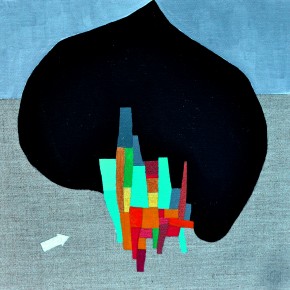Guido “108” Bisagni recently exhibited new work at Ego Gallery in Lugano Switzerland. The show titled Seventeen Dens brings together a range of work from 108 the Italian born artist. 108 has transitioned from traditional graffiti in his youth to a more esoteric and sublime body of work. An excellent show that establishes 108 as a emerging contemporary painter who is able to create intense images with the subtlest of images.
GF
“There are 108 earthly temptations one must overcome to achieve Nirvana; according to Buddhists and Hindus, mantras should be repeated 108 times; 108° is the angle of the Pentagon – one of the most important angles that comprise the golden ratio. 108 is also a fascinating number for Guido Bisagni (Alexandria, 1978) who has chosen this number as his pseudonym for quite some time now. This figure intrigues the creator both due to its poetic and esoteric connotations as well as for its formal appearance: stripping the number 108 down to the bone leaves us with only a line and three circles. At the end of the 90s, following contemporary artists such as Stak, Guido Bisagni began a new personal quest to become one of the first artists of the Post-European graffiti to leave lettering, so as to focus on this mysterious sequence of numbers. The artist is also an innovator in the use of the shape: his first known works are yellow abstract organic shapes cut out from self-adhesive paper in an instinctive and compulsive manner. In fact, 108 has contaminated several cities, including Milan, Berlin, New York, London, Paris and Oslo with at least 3000 of his adhesive stickers, influencing a whole generation of street artists with his style. As time went by, 108 began a dark and introspective journey that heavily influenced his works. Violently breaking away from the “pop” trend, he explored pure form, full of symbolic meaning. This research led him to radically distance himself from any representation of the real and known, allowing himself to become strongly influenced by primitive art, by ancient local shamanism and by the propitiatory character of rock carvings. Eclectic and curious, Guido Bisagni absorbs any seemingly insignificant visual suggestions like a sponge, to then rework and develop them into unique works of art. Amongst his sources of inspiration he cites “the dreams and red wine of Piedmont, the stains of moisture, moss and fog, stones, trees, winter with its snow, Etruscan writings, runes, snails, cats and all that is incomprehensible.” The result: his canvases and his huge murals depicting black silhouettes are transformed into secular menhir full of meaning, into ghosts of the past ready to interfere with our present, into bridges which start from the ground on which we stand and end somewhere in the unknown.”




































